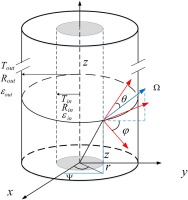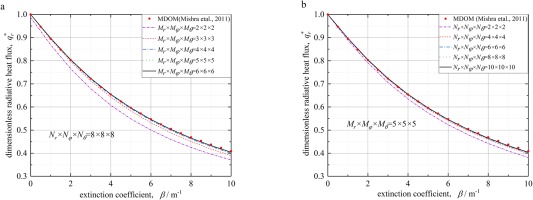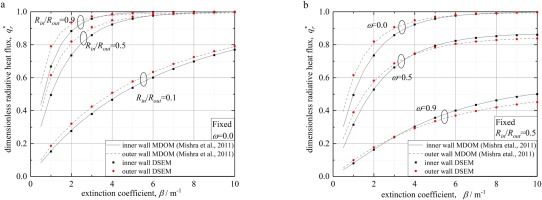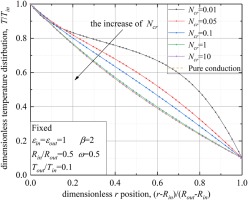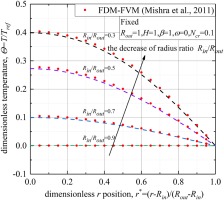Introduction
The higher turbine inlet temperature means higher thermal efficiency and power output. Therefore, the ability to operate at higher temperature has been an important factor in improving the performance of aero-engines. Over the past few decades, the turbine inlet temperature has increased from 1,000 K in the first generation to more than 2,000 K Yin and Rao (2020) in the latest generation aero-engines. The increase of temperature and the fact that total amount of radiation rises as the fourth power of the absolute temperature Howell et al. (2020) determine that the radiation and coupled radiation-conduction heat transfer play more and more important roles in hot section of aero-engines.
The radiation and coupled radiation-conduction problems in aero-engines involve two equations: radiative transfer equation (RTE) and energy equation. Considering the cylindrical symmetry of aero-engines, these two governing equations can be expressed in more simple way using cylindrical coordinate which could bring a lot convenience like the implement of boundary conditions. Different from conduction and convection in which only spatial dimension need to be concerned, because of the directional nature of radiation, the angular distribution of radiation also need to be calculated for radiation heat transfer problem. This angular dependence adds to two more dimensions, i.e. polar angle and azimuthal angle. This characteristic of angle-dependent would bring great challenges to the numerical computation. Besides, RTE, the governing equation of radaiton heat transfer, can be considered as a kind of convection-dominated equation from the point of numerical computation. The characteristic of convection-dominated of RTE means that it is very difficult to obtain a stable and accurate numerical solution. The features of radiation heat transfer introduced above determine that solving RTE and obtaining the radiation distribution are the most important and difficult part for both radiation and coupled radiation-conduction heat transfer problems.
In recent years, the radiation and coupled radiation-conduction heat transfer in cylindrical system have evoked wide interests of many researchers. As early as 1982, Fernandes and Francis (1982) gave the rigorous formulations of combined conduction and radiation in concentric cylinders and solved it by Galerkin finite element method. Pandey (1989) employed undetermined parameters method to solve this coupled problem for gray and nongray gases contained between infinitely long concentric cylinders with black surfaces. Aouled-Dlala et al. (2007) investigated coupled radiation-conduction heat transfer in gray hollow spheres and cylinders. They used finite Chebyshev transform (FCT) to improve the performance of discrete ordinates method, and adopted Chebyshev polynomials to approximate the angular derivative term instead of finite difference scheme. The results show that FCT is more accurate than traditional discrete ordinate method. Mishra and Krishna (2011) adopted modified discrete ordinate method (MDOM) and lattice Boltzmann method to analyze coupled radiation-conduction heat transfer in infinite and finite concentric cylinders with absorbing, emitting, and scattering medium.
In this paper, the discontinuous spectral element method (DSEM) is adopted to solve the radiation and coupled radiation-coduction heat transfer in cylindrical coordinate system. For the numerical solution of RTE, the space-angle scheme is used to deal with the lack of angular resolution problem which exists in the results of RTE. Space-angle scheme means both the spatial and angular computational domains of RTE are discretized and solved by DSEM. The results demonstrate that the space-angle DSEM performs much better than the traditional hybrid methods. For coupled radiation-conduction heat transfer problem, spectral element method (SEM) is adopted to solve the energy equation after the radiation distribution is obtained by DSEM and then substituted into the energy equation as radiative source term. This kind of DSEM-SEM scheme could avoid using two sets of grid which would cause the increase of computational cost and the decrease of accuracy. And the results show that this DSEM-SEM scheme is feasible to solve the coupled radiation-conduction heat transfer problem. Then, the effects of various geometric and thermal physical parameters are comprehensively investigated. Finally, these methods are further extended to 2D cylindrical system.
The paper is organized as follow. In section 2, RTE in concentric cylindrical medium and numerical method are introduced. In section 3, the numerical results of radiation and coupled radiation-conduction heat transfer in both 1D and 2D cylindrical system are presented and analyzed. Finally, conclusions are summarized in section 4.
Methodology
RTE in concentric cylindrical medium
As shown in Figure 1, the present paper studies the radiation and coupled radiation-conduction heat transfer in cylindrical coordinate system. The
The RTE in one-dimensional cylindrical gray medium can be written as Modest and Mazumder (2021),
with the boundary conditions:
where
where
In this paper, the symmetry of one-dimensional cylinder is used. Therefore, the computational domains of 1D case are,
Discontinuous Galerkin method
The discontinuous Galerkin method (DG method) Cockburn (2003) combines features of the finite element and the finite volume framework. Unlike traditional continuous Galerkin method, the DG method works over a trial space of functions that are only piecewise continuous. This means the solution can possibly has a different values on the shared boundary of different elements. An alternative formulation, the so-called weak formulation, is used to get a representation as a piecewise polynomial, in which the polynomial is discontinuous at the element boundaries. The transport equation is taken as an example to introduce the implementation of DG.
First, the solution domain
Then, we need to derive the weak form of the PDE Equation 5. Multiply both sides of Equation 5 by a differentiable test function v, and integrate the resulting equation over the space E to get,
using integration by parts,
where
The calculation of DG is carried out on each element, and DG establishes a link between the values of solution in different elements only through flux on the boundary. Therefore, the numerical flux
where the operator
Here the superscript operator “
Spectral element discretization
In spectral element discretization Patera (1984), the nodal basis functions on each element are constructed by Chebyshev polynomial expansion. For one-dimensional case in standard computing domain
After the construction of basis functions, quantity u to be solved in any position on element can be approximated as,
where
Discontinuous spectral element method discretization of RTE
In order to use DSEM to discretize RTE in cylinderical coordinate system, it is necessary to use the mathematical equivalent form instead of the usual form of the RTE given by Equation 1. However, as shown in Equation 1, there exists a minus sign
where the dependences of I on r and
Physical meaning of the two mathematical equivalent forms
As mentioned before, the computational domain of 1D case is:
It is obvious that the only difference between the two mathematical equivalent forms lies in the boundary integral term
First, we consider Form a. For the case when
The equation above means that
For the case when
The equation above means that
Similarly, the physical meaning of Form b can be analyzed in the same way. For the case when
The equation above means that
When
The equation above means that
In conclusion, the physical meaning of Form b is that in
Radiation propagation in cylindrical coordinate system
In angular direction
Figure 3.
The two typical propagations of the radiation in r − φ
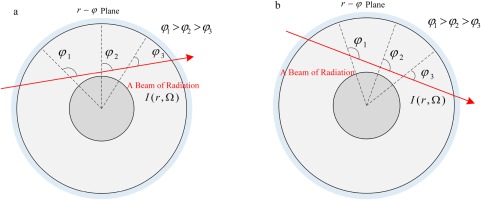
It can be seen that the physical meaning of Form a is consistent with the physical reality of radiation propagation in the cylindrical coordinate system while the physical meaning of Form b is just the opposite. Therefore, the Form a (equation 14a) is the mathematical equivalent which we should choose in this paper while the Form b is not allowed to be used.
Spectral element method discretization of energy equation
For copuled radiation-conduction heat transfer problem in cylindrical coordinate system, different from the RTE which involving three-dimensional
where k is thermal conductivity,
Since the coupling between the energy equation and the equation of radiation transfer is highly nonlinear due to the relationship between
The energy equation Equation 19 is a classical elliptic equation. Therefore, a good result can be obtained by directly using the spectral element method (SEM) without introducing discontinuous Galerkin scheme. The mesh of SEM adopts the same number of elements and nodes as DSEM to avoid using two sets of computational grid which would cause the increase of computational cost and the decrease of accuracy. Applying the SEM to Equation 19, we can obtain:
The extension to 2D cylindrical system
Figure 4 depicts the 2D cylindrical system, the z direction need to be considered compared with 1D case. Therefore, from the mathematical point of view, the radiation heat transfer problem in 2D cylindrical system considered here is actually 4D case, the polar angle
Radiation propagation in the 2D cylindrical system
The RTE in 2D cylindrical gray medium is,
The boundary conditions of gray walls we considered in this paper are:
There also exists the symmetry for 2D cylinder and the domains we need to considered are,
Similar to the analysis in 1D cylinder case, for the successful implement of DSEM, the mathematical equivalent form of Equation 21 we need to choose is.
And the corresponding formula after applying DSEM to Equation 24 is,
Coupled radiation-conduction problem in the 2D cylindrical system
The copuled radiation-conduction heat transfer problem in 2D cylindrical system involves two-dimensional
After applying the SEM to Equation 26, we would obtain:
Result and discussion
Grid independence tests
The grid independence tests are conducted in this section. Radiative equilibrium situation is considered firstly, the radius ratio of concentric cylinder
Radiation heat transfer in 1D cylindrical system
Note that the radiative equilibrium problem is already considered in the grid independence tests above, then another typical radiation heat transfer problem, non-radiative equilibrium case would be numerically analyzed in the following section.
For non-radiative equilibrium problem, the radiative participating medium is the radiation heat source. The concentric cylinder boundaries remain cold, i.e.
Coupled radiation-conduction heat transfer in 1D cylindrical system
Table 1 shows the dimensionless total heat flux in inner wall
Table 1.
Values of the dimensionless total heat flux in inner wall q t ∗ ( R i n ) q t ∗ ( R o u t )
After verifying the feasibility of DSEM-SEM scheme, we study the effects of conduction-radiation parameter
The conduction-radiation parameter
The radiation and coupled radiation-conduction heat transfer in 2D cylindrical system
The radiation heat transfer in 2D cylindrical system
The non-radiative equilibrium is considered in 2D cylindrical system. The inner, outer, up and down walls of the 2D cylinder are all cold, i.e.
Figure 8.
The influence of different radiative heat transfer parameters on dimensionless radiative heat flux q r ∗ β ω
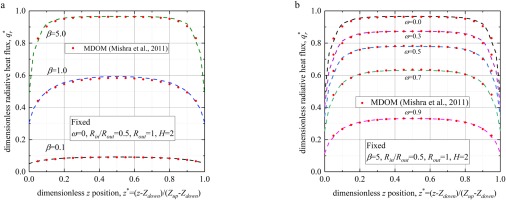
Figure 8 shows the results of DSEM in the 2D cylinder case, the results are compared with those of modified discrete coordinate method (MDOM) in ref. Mishra et al. (2011). The comparison shows that in various cases, the results of DSEM are all in good agreement with those in reference, which verifies the feasibility of DSEM in two-dimensional cylindrical system. The effects of different radiative heat transfer parameters on dimensionless radiative heat flux
Figure 8a shows the influence of extinction coefficient
The influence of scattering albedo
Coupled radiation-conduction heat transfer in 2D cylindrical system
In this chapter DSEM-SEM scheme would be extended from 1D cylinder case to solve the coupled radiation-conduction problem in 2D cylindrical system. The results solved by Finite Difference Method-Finite Volume Method (FDM-FVM) in ref. Mishra et al. (2011) are also presented for comparison, in which the radiative intensity are obtained by FVM while the energy equation is solved by FDM.
In this case, the height of 2D cylinder
Figure 9 shows the influence of radius ratios
Conclusion
In this paper, two different kinds mathematical equivalent forms of RTE in cylindrical coordinate system are studied and compared. Through the analysis from the perspective of physical meaning, the correct form of RTE in cylindrical coordinate system used for DSEM is given. Then, both the spatial and angular domain are discretized by DSEM to solve the radiation heat transfer problem in cylinderical system. Besides, considering the numerical characteristics of both RTE and energy equation, DSEM-SEM scheme is proposed to solve the coupled radiation-conduction problem. Then, several cases are given and analyzed to prove the feasibility for solving radiation and coupled radiation-conduction heat transfer in cylindrical system, Finally, these methods are further extended to 2D cylindrical system which is closer to the real case of aero-engines.

